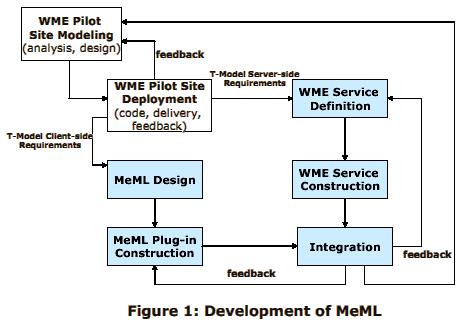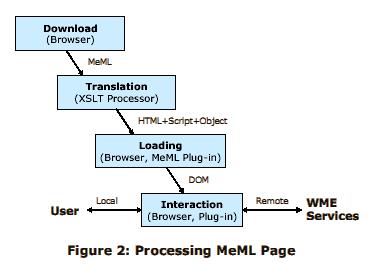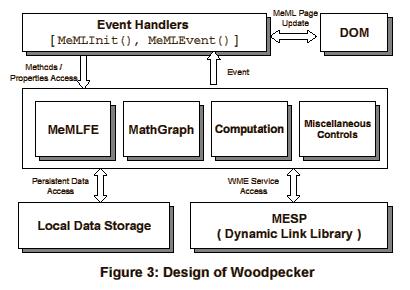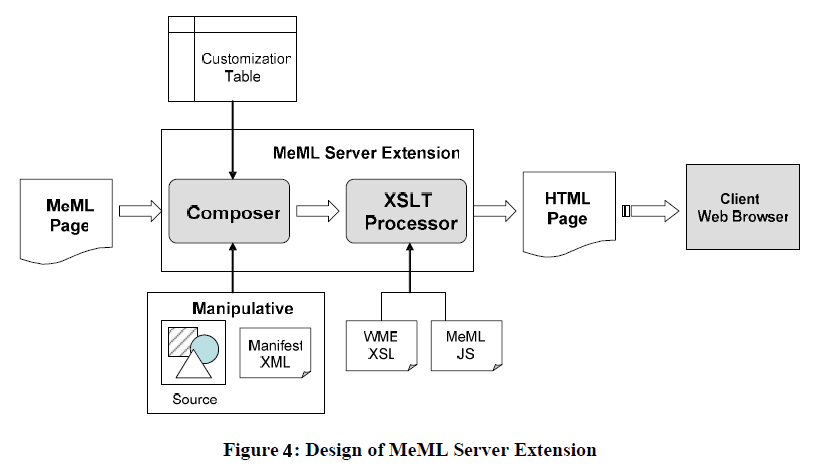
| MeML HOME | About Author | Milestones | Progress&Status | Software | Documentation | References | |

MeML: Mathematics Education Markup Language
Overview
 MeML
is designed to provide effective and expressive means for structuring and delivering mathematics education
content on the Web. It also provides the functions to manipulate dynamic mathematics computation and to
model the educating activities that are essential to online teaching.
MeML
is designed to provide effective and expressive means for structuring and delivering mathematics education
content on the Web. It also provides the functions to manipulate dynamic mathematics computation and to
model the educating activities that are essential to online teaching.
The design of MeML is not an independent work. It is not just a way to represent conventional textbook in Web page. It takes into account the structural storage of education content, the Teaching Model, and the dramatic influence that online teaching tools make to traditional Teaching Model. Its definition is a result by examining current textbook and online math materials, testing mathematics courseware, consulting education experts, following NCTM principles, and obtaining experience from our RAD prototype - Kimpton Pilot Site. Figure 1 shows the diagram about how we get experience and extract T-Model from the construction of Kimpton Pilot Site.
Definition of MeML
MeML is defined by XML. MeML elements (markup tags) can be used together with MathML, XHTML, and other XML-compatible languages to structure an Active Lesson (AL). MeML elements are designed to capture the macro structures inside an AL and create interoperable page elements, making them self-contained and easily interchangeable among ALs. Such an organization can also enhance interactions and communications among these page elements.
MeML defines about 54 elements, which are grouped into five categories: content elements, education elements, organization elements, computation elements, and system elements. Table 1 lists all categories as well as elements of each category.
|
Category |
Elements |
|
Content |
concept, skill, terminology, problem, identity, theorem, formula, diagram, equation, algorithm, definition, property, operation, notation |
|
Education |
lesson, example, exercise, assessment, homework, test, remediation, question, diagnosis, answer, solution |
|
Organization |
abstract, syllabus, roster, guide, hint, chapter, summary |
|
Computation |
variable, expression, computation, mathgraph, assign, range, with, condition, function |
|
System |
certifieduser, monitor, editable, userinput, interaction, use, parameter, wmeservice, configure, sensitive, manipulative, deploy, vsection |
Woodpecker - Client side MeML Processor
As a new XML language, MeML is not directly suppported by current Web browsers, especially, when MeML tries to model both education content and the activities of teaching. So, we develop a pre-processor for MeML to wok in popular Web browsers like IE and NN. We name it as 'Woodpecker' because our WME Group works so hard just like a woodpecker trying to drill a future of WME in the tree of online education with all kinds of uncertainty surrounded.
 Woodpecker works as a browser plug-in which translate incoming MeML page into a regular
XHTML page with CSS, JavaScript , and special in-page objects before MeML page is loaded
into browser. After the page is loaded, Woodpecker keeps monitoring the interaction between
user and page. It picks up in-page envents in the case that MeML page is requiring remote
WME services to serve dynamice page content. Figure 2 show the step how Woodpecke process
MeML page in Internet browser. Figure 3 shows the module design of Woodpecker.
Woodpecker works as a browser plug-in which translate incoming MeML page into a regular
XHTML page with CSS, JavaScript , and special in-page objects before MeML page is loaded
into browser. After the page is loaded, Woodpecker keeps monitoring the interaction between
user and page. It picks up in-page envents in the case that MeML page is requiring remote
WME services to serve dynamice page content. Figure 2 show the step how Woodpecke process
MeML page in Internet browser. Figure 3 shows the module design of Woodpecker.

MeML Server Extension - Server side MeML Processor
MeML Server Extension has following advantages comparing to Woodpecker.
- There is no requirement to install software packages at client side.
- MeML page is processed at server-side. Therefore, the customization of per page for per teacher could be supported.
- Export/Import of interoperable components between lesson pages could be easier.
- A complete Concept Map can be generated for all lesson pages on server. So it is easier and more efficient to implement knowledge navigation.
- Server-side processing could completely separate site organization and site specific content from MeML content to improve dynamic support and interoperability. It is harder for client-side processing to do so because client has less context information than server.

About the author
Name: Xiao Zou
Milestones
Spring 2006
- Add support to SVG-based manipulatives. Export SVG maniopulative to 'boar'
- Change definition of 'reference' tag. Behavior of manipulative is completely decided by its 'manifest.xml'
- Drop the implementation for MeML tag 'certifieduser'.
- Export MeML Server Extension to our new 'boar.cs.kent.edu'
- Export WME Services to 'boar.cs.kent.edu'
- Create WME Computation Service
- Build Math Computation Seesion Manager on 'b1.cs.kent.edu'
- Create WME Account & Profile Service
- Prototype of MeML Server Extension
Progress & Status
Software
Documentation
WME Model Site Tutorial
Developer's Guide to MeML
MeML Poster
References
- The Education Resources Information Center (ERIC), sponsored by the Institute of Education Sciences (IES) of the U.S. Department of Education www.eric.ed.gov.
- The Eisenhower National Clearinghouse for Mathematics and Science Education www.enc.org/features/lessonplans/math/.
- Proceedings of the IAMC 1999, 2001, 2002, and 2003 Workshops, icm.mcs.kent.edu/research/iamc.html#iamcworkshop.
- Institute for Computational Mathematics, demos of mathematical computation icm.mcs.kent.edu/research/demo.html.